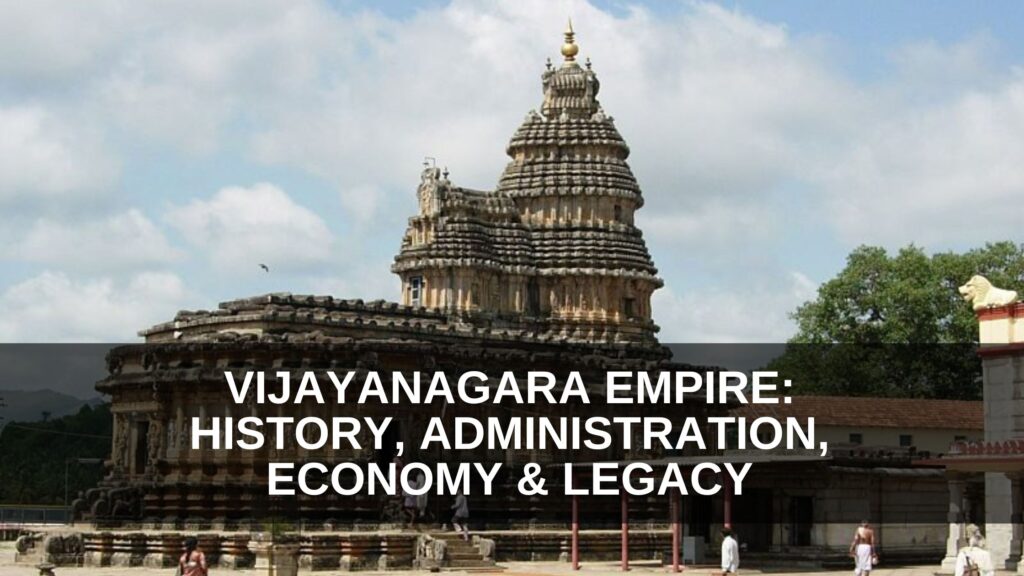The Vijayanagara Empire (1336-1646 AD) was one of the most powerful and culturally rich empires of medieval India. Situated in Southern India, it encompassed modern-day Goa, Karnataka, Andhra Pradesh, Tamil Nadu, Kerala, Telangana, and parts of Maharashtra. This empire flourished for more than two centuries before its decline after the Battle of Talikota (1565 CE).
Let’s delve into the origin, administration, economy, art, literature, and legacy of this magnificent empire.
Origin of the Vijayanagara Empire
The Vijayanagara Empire was founded by Harihara I and Bukka Raya I in 1336 AD. Originally serving as feudatories under the Kakatiyas of Warangal and later as ministers in the Kampili kingdom, they were captured and converted to Islam after Kampili fell to the Delhi Sultanate. However, under the guidance of the Hindu sage Vidyaranya, they reconverted to Hinduism and established the Vijayanagara Empire, with its capital at Vijayanagar (Hampi, Karnataka).
The empire emerged as a powerful entity, successfully resisting northern invasions and securing its dominance in Southern India.
Download notes of The Great Rajput Dynasty
Dynasties of Vijayanagara
The empire was ruled by four major dynasties:
- Sangama Dynasty (1336-1485 AD) – Founded by Harihara I and Bukka Raya I.
- Saluva Dynasty (1485-1505 AD) – Short-lived, ruled by Saluva Narasimha.
- Tuluva Dynasty (1490-1570 AD) – Marked the peak of Vijayanagara’s power, ruled by Krishnadevaraya.
- Aravidu Dynasty (1570-1646 AD) – Continued to rule in a diminished capacity after the Battle of Talikota.
Prominent Rulers and Their Contributions

Harihara I (1336 – 1356 AD)
- Expanded the empire south of the Tungabhadra River.
- Earned the title “Master of the Eastern and Western Seas.”
Bukka Raya I (1356 – 1377 AD)
- Defeated the Sultan of Madurai and extended the empire to Rameswaram.
Deva Raya I (1405 – 1422 AD)
- Encouraged secular policies, employing Muslim soldiers in his army.
- Constructed mosques and slaughterhouses for the Muslim population.
Deva Raya II (1422 – 1446 AD)
- Extended the empire from Ceylon to Gulbarga and Orissa to Malabar.
- Built the Hazara Rama temple at Hampi.
Krishna deva raya (1509 – 1529 AD)
- Considered the greatest Vijayanagara ruler.
- Expanded the empire from River Krishna to River Kaveri and from the Bay of Bengal to the Arabian Sea.
- Established friendly relations with the Portuguese in Goa, acquiring guns and Arabian horses.
- Defeated Bijapur Sultanate in the Battle of Raichur (1520 AD).
- Strengthened administration and military, promoting centralized governance.
- Was a patron of literature, composing “Amuktamalyada” in Telugu.
- Established a court of eight eminent poets (Ashtadiggajas).
Fall of Vijayanagara Empire
The empire’s decline began after Krishnadevaraya’s death, leading to power struggles. In 1565 AD, the Battle of Talikota saw a coalition of Deccan Sultanates (Ahmednagar, Bijapur, Golconda, and Bidar) defeat Vijayanagara. The capital city, Hampi, was plundered and destroyed, marking the empire’s downfall.
Administration of Vijayanagara Empire
The Vijayanagara Empire was known for its efficient governance. It was divided into:
- Rajyas or Mandalams (provinces)
- Nadu (districts)
- Sthala (sub-districts)
- Grama (villages)
Key Administrative Systems
- Nayankara System: Land was assigned to military chiefs (Nayakas) in return for military service and financial contributions.
- Ayagar System: Village administration officials (Ayagars) maintained law and order.
- Taxation: Included land revenue, property tax, sales tax, professional taxes, and military contributions.
Economic Prosperity
The Vijayanagara Empire had a flourishing economy based on agriculture, trade, and commerce.
- Land Revenue: The primary source of income, varying based on land fertility.
- Irrigation Systems: Large tanks (Anicut or Bund) were built to support agriculture.
- Trade and Commerce: The empire traded with Persians, Arabs, Portuguese, and Chinese.
- Coinage: The empire used gold, silver, and copper coins.
Art, Architecture, and Literature
The Vijayanagara period saw an extraordinary development in architecture, literature, and performing arts.
Architectural Marvels
- Hazara Rama Temple (built by Deva Raya II)
- Virupaksha Temple at Hampi
- Vitthala Temple (famous for its stone chariot and musical pillars)
- Kalyana Mandapams (marriage halls) decorated with intricate carvings of horses, elephants, and deities.
Literature and Performing Arts
- Sanskrit and Telugu literature flourished.
- Krishnadevaraya’s court had Ashtadiggajas, eight great poets.
- Carnatic music and Bharatanatyam dance developed significantly.
- Bronze sculptures depicting gods, goddesses, and court life were prominent.
Foreign Travelers and Their Accounts
Many foreign travelers visited Vijayanagara and documented its grandeur:
- Niccolò de’ Conti (Italian, 1420 AD): Described prosperous cities and Sati rituals.
- Abdur Razzak (Persian, 1443 AD): Wrote about the luxurious lifestyle of Vijayanagara nobles.
- Domingo Paes (Portuguese, 1520 AD): Praised Krishnadevaraya’s rule and military strength.
- Fernao Nuniz (Portuguese, 1535 AD): Described trade, markets, and social structures.
Download notes of Impact of Delhi Sultanate
Legacy of the Vijayanagara Empire
Despite its fall, the Vijayanagara Empire left a lasting impact on South Indian culture. Many of its administrative, economic, and artistic traditions influenced later kingdoms like the Marathas, Nayakas, and Mysore rulers.
Even today, Hampi, the capital of Vijayanagara, stands as a UNESCO World Heritage Site, attracting scholars and tourists from across the world.
The Vijayanagara Empire was a golden era of South Indian history, known for its political power, economic prosperity, military strength, and artistic achievements. Though it declined after the Battle of Talikota, its cultural and architectural contributions continue to inspire generations.


